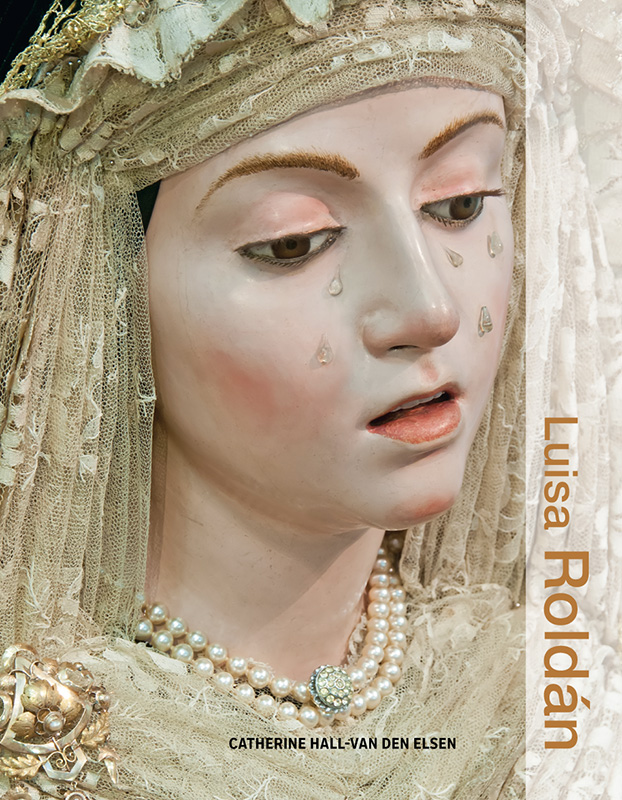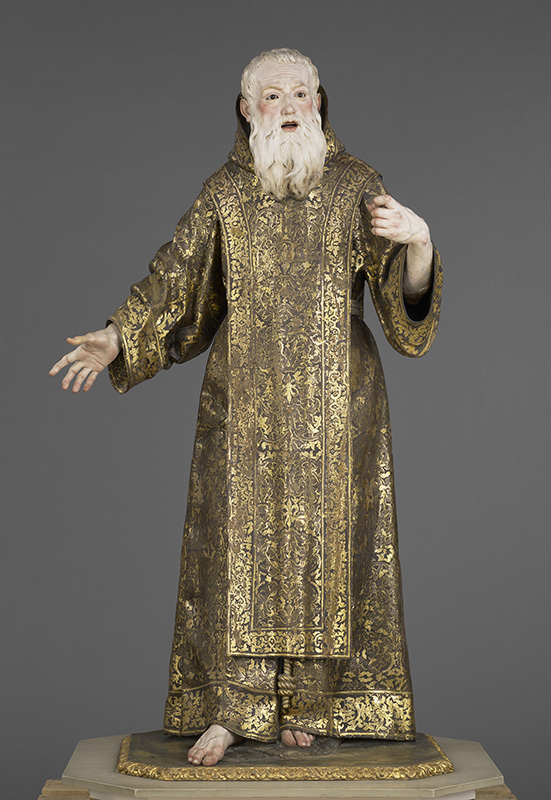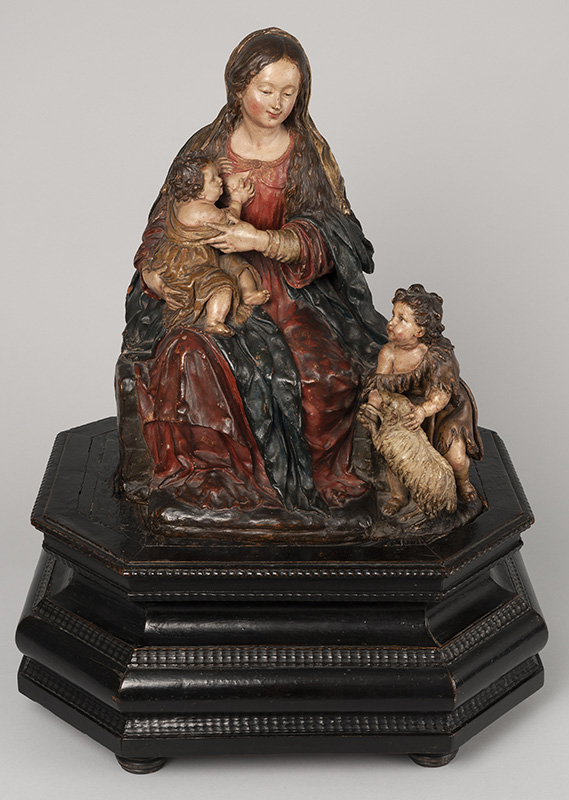The Astonishing Sculpture of Luisa Roldán
by Kate Burnett Budzyn
The first in a new series of books on early modern women artists highlights the oeuvre of an overlooked 17th-century Spanish sculptor.
On the cover of Catherine Hall-van den Elsen’s new monograph—the first in Getty Publications’ Illuminating Women Artists series—is Our Lady of Solitude, an image of a female figure gasping in tears (figure 1). Beneath a veil of ecru lace, the figure’s head tilts slightly, the candylike gloss of her skin contrasting with the gatherings of the surrounding fabric. She is arresting, a tour de force of texture, color, and form.
Perhaps as astonishing as this hyperreal apparition is the fact that she reaches out to us directly from 17th-century Spain, where her head and hands were carved in wood by a woman, Luisa Roldán. Born in 1652 into a patriarchal society which, much like our own, had been rocked by bouts of flood, drought, and plague, Roldán might strike us today as an unlikely success story. As Hall-van den Elsen demonstrates over the course of this revelatory book, however, Roldán was a prominent working artist in her day, recognized for her skill in three major Spanish Baroque cities, all of which are included in the Decorative Arts Trust’s upcoming Study Trip Abroad to Andalucía.
Roldán’s father was a renowned sculptor in Seville, where he made a living producing life-sized polychromed wooden religious figures, a popular art form displayed in Catholic churches and used in pageants throughout the city. Luisa—whom Hall-van den Elsen refers to by her first name in order to distinguish the artist from her relatives—began learning her father’s craft in childhood. She trained as a sculptor alongside his other apprentices, but her abilities were never formally recognized by a guild. At age 19, against her father’s will, she successfully petitioned ecclesiastical authorities for permission to marry another sculptor in the shop, Luis Antonio de los Arcos.
By Luisa’s early 30s, Luis Antonio was receiving major commissions under his own name, and the couple worked as collaborators, although their distinct roles in producing sculptures are hard to parse. The earliest known documentation of Luisa’s authorship—a 1684 note found inside the head of a figure of Christ wearing the crown of thorns—indicates that by that date she had established an independent reputation as a sculptor: “This work was done by the hands of the esteemed artist Doña Luisa Roldán in company with her husband Luis Antonio de los Arcos…”
Around 1689, pregnant with her seventh child, Roldán moved to Madrid, where she and her husband hoped to receive the attention and support of the Spanish Court. Here, Roldán produced a few of her finest wooden figures, including San Ginés de la Jara (figure 2). The saint’s gilded vestments cascade down his front, providing a luxurious expanse for the glimmering estofado—a painting technique in which layers of colored tempera were applied atop gold leaf and then scraped off in patterns to imitate textiles. Recalling Our Lady of Solitude in its encarnación—the painting of flesh tones—the figure’s pale white feet and bulbous pink toes are at once disarmingly human and almost confectionary in their pastel coloring. It is hard to imagine the impact such a lifelike figure would have had on 17th-century viewers, who were not immersed as we are in a visual culture of lens-based simulacra.
Within a few years of arriving in Madrid, Roldán was named Escultora de la Casa Real (Sculptor of the Royal Household), but a few remaining letters to her royal benefactors indicate that she was not adequately paid for her commissions, and the family experienced financial struggles. Roldán began producing small-scale figural groups in polychromed terracotta. Women, children, and babies dominate these intimate religious compositions made for display in private chapels and salons (figure 3). In one haunting example, angels care for Mary Magdalene as she reclines in her ecstasy, her familiar story receiving new life through Roldán’s sensitive treatment (figure 4).
The triumph of this book, the first English-language catalogue of Roldán’s work, lies in Hall-van den Elsen’s heroic piecing together of an oeuvre that has been severely fragmented. Several important works are known to have been destroyed in the 1930s during the Spanish Civil War, and others are damaged or missing. Given limited documentation and the fact that Roldán rarely signed her works, it is often difficult to tease out her individual authorship from that of her father and husband. What’s more, Sevillian polychromed sculpture was fundamentally collaborative: members of a shop worked together to carve multifigured works, and the polychromy was typically applied by separate artists, whose role was protected by Seville’s painters’ guild. Although the book’s image captions do not (and perhaps cannot) reflect the complexities of the sculptures’ authorship, Hall-van den Elsen does an impressive job of sorting through these complications in the text.
The author moves carefully through the artist’s known oeuvre and biography and devotes much of the text to straightforward visual description of the sculptures, as if working to reclaim the artist’s technical skill from a historiography that has tended to essentialize her gender and undermine her talent. Despite this careful coverage, there remains an unanswered urgency in Roldán’s provocative objects. Page after page of her figures writhe with energy and pathos, their tactility seeming to ache for human connection. These sculptures demand more critical attention than Hall-van den Elsen can possibly give them in the space of this introductory text, and she acknowledges this clearly, calling for further scholarship.
As compelling as we may find this artist’s rarity as an early modern female sculptor, Roldán’s work poses questions on its own terms. Begging for communion across time, her sculptures remind us that they were, in fact, celebrated in their day—that they were powerful, active participants in the visual culture. Take a second look at Our Lady of Solitude and you’ll almost hear her sigh as she asks us what it is about our time and our curious narratives of women and art that has left her largely forgotten until now. Thanks to this exquisite book, English readers now have a chance to enter the conversation.
Kate Burnett Budzyn is a contributing writer for the Decorative Arts Trust and is the Book Review Editor at Winterthur Portfolio.
A print version of this article was published in The Magazine of the Decorative Arts Trust, one of our most popular member benefits. Join today!




